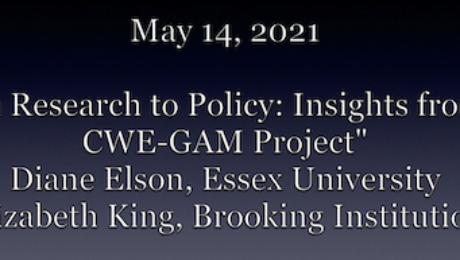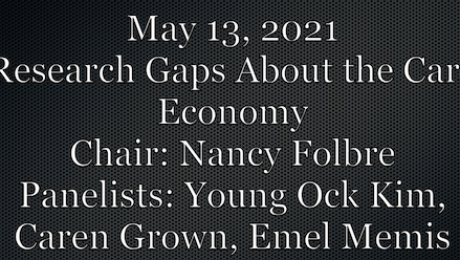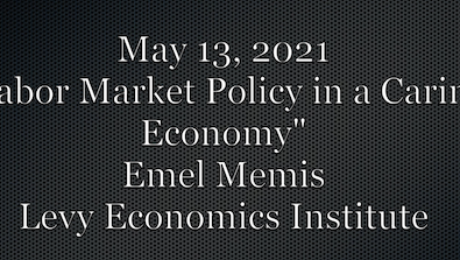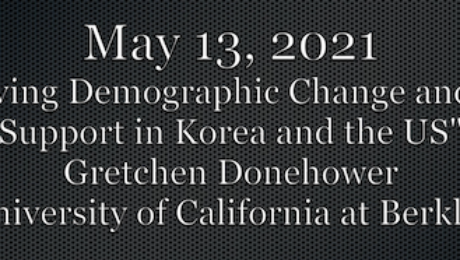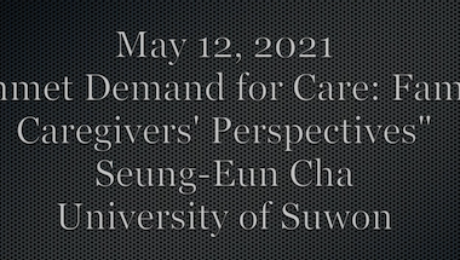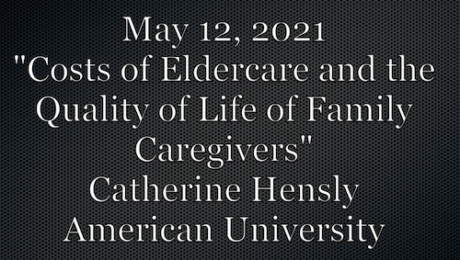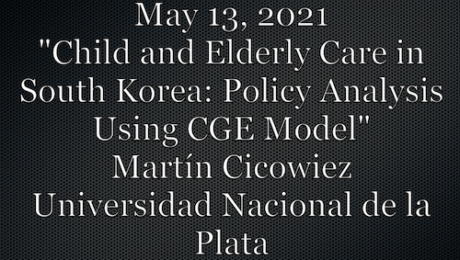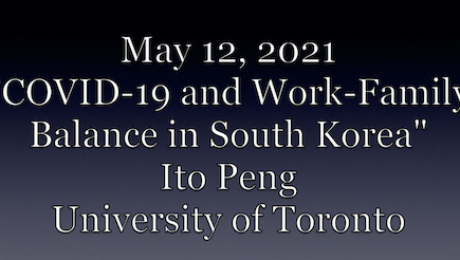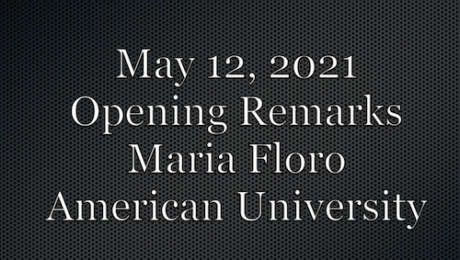Insights on Research to Policy
As the Care Work and the Economy project is closing out this chapter, it is important to look at any lessons learned and turn toward the future of the field. In the final day of the Concluding Annual Meeting, Dr. Elizabeth King, Co-Principal Investigator of the project, gives an overview of policy lessons from the research project.
A theme that summarizes the lessons from the project is “care for all” which acknowledges that everyone is in need of care, not just the young, sick, and elderly, but also care workers and everyone else in between. The actors in a care economy include individuals/families/communities, paid care workers, private sector employers, and the government at all levels. The Care Work and the Economy project had papers written about each of these actors. Through policy simulations, macroeconomic models that explicitly include gender and care work, and time use and household surveys, the researchers were able to analyze the interactions and behaviors of the actors in the care economy. The flow of care services between the actors is determined by policies or social norms. Each set of actors has a way to contribute as a giver and receiver of care. The COVID-19 pandemic revealed that the care burden still falls disproportionately on women so there is much work to do. The lessons and findings from this project should be carried forward while there is momentum and attention towards care infrastructure and economy.
To watch Dr. King’s full keynote presentation, see below.
Written by Catherine Falvey, Research Assistant for the Care Work and the Economy project and PhD student in Economics at American University
- Published in Conferences, Expert Dialogues & Forums, Policy
Research Gaps about the Care Economy
To wrap up the second day of the Concluding Annual Meeting, Dr. Nancy Flobre (University of Massachusetts Amherst) chaired a discussion on future avenues for research in the field of care economy. Young Ock Kim (Korean Women’s Development Institute) suggested modifying existing macroeconomic models and going beyond the models being used currently. Kim pointed out that research could also focus on the recovery from the COVID-19 pandemic and that some surveys might need to adjust their timelines to make sure that the effects of the pandemic are captured. Finally, it is vital to encourage young researchers to engage in care economy research, and a research fund could achieve this objective.
Dr. Emel Memiş (Levy Institute) emphasized the importance of gathering quality information for future research. Memiş’highlighted current data challenges such as the lack of complete information on income and consumption patterns of the households, the need for more classifications for time use data and detailed information on paid work time use and paid work activities, the lack of data on the intersection of inequalities such as regional inequalities, and ethnic-based inequalities. In conclusion, high-quality data is necessary for research that encapsulates all aspects of wellbeing, economic and non-economic life activities.
The need for strategies to incorporate new technology to collect data and disseminate research findings was Dr. Caren Grown’s (World Bank) main message. Furthermore, research needs to focus on low-income, low resource, transitioning, and emerging economies so that models could be developed to include the idiosyncrasies of these types of economies. When conducting research, it is also important to distinguish between different risk profiles and the different types of care populations. Grown encouraged the research community to be innovative in disseminating research findings to reach a wider audience.
To watch the full presentation, see below.
Written by Praveena Bandara, Research Assistant for the Care Economy Project and PhD student in Economics at American University.
- Published in Conferences, Expert Dialogues & Forums, Policy, Research
Labor Market Regulation Policy Simulations
Care responsibilities often fall disproportionately on women and can be a roadblock to full time employment. Labor market regulations could be a way to make the share of unpaid care work time more equitable between men and women and could make it easier to participate in paid work more. During the second day of the Concluding Annual Meeting, Dr. Emel Memiş presented her research with Dr. Ipek Ilkkaracan that explored the impact of regulations of labor market working hours on paid employment and unpaid care work hours.
The study used two simulations to see the effect of reducing the maximum working hours from 68 hours to 52 and 40 hours. The data they used is the Care Work Family Survey Data conducted by the Care Work and the Economy project in South Korea. This allowed them to look at time allocation for tasks within households, use of paid childcare services, and paid employment time. The conceptual idea behind the policy simulation of reducing working hours is that men would have more time to dedicate to care work which would lower women’s time in care work and increase their paid work.
The simulations found evidence to support the conceptual hypothesis- reducing work hours for men increased their care work time, decreased their wives care work time and increased their wives paid work. Specifically, reducing the working hours to 40 hours led to an average increase in men’s care work time by almost 5 hours, and an average increase in women’s paid work time by 7 hours. These results are important because they show that the labor market working hour regulation policy has the potential to significantly reduce the gender gap in paid employment hours and improve the quality of life of workers with large care burdens.
To watch the full presentation, see below.
Written by Catherine Falvey, Research Assistant for the Care Work and the Economy project and PhD student in Economics at American University
- Published in Conferences, Expert Dialogues & Forums, Policy
Evolving Demographic Change and Care Support in South Korea and the US
Care support ratios are a simple method to evaluate how demographic change may impact care economies while including the unpaid care work part of the economy, often overlooked. During the second day of the Concluding Annual Meeting, Dr. Gretchen Donehower (University of California at Berkley) presented collaborative research with Dr. Bongoh Kye (Kookmin University, South Korea) that examines whether the production of care could sustain its consumption by combining current age profiles of the society with possible future demographic changes that could occur in the US and South Korea
To calculate care support ratios, you must first estimate current age profiles of some type of care, i.e., eldercare or childcare. Secondly, you need to produce these ratios for some scenarios of future change, i.e., population projections that take the effect of the aging population on the care economy into account. Finally, you estimate the aggregate production and consumption based on the age profiles of this future scenario and take the ratio of the two to give you the care support ratio.
The current age profiles show that women perform a significant proportion of unpaid, non-professional, and professional care work in the US and South Korea, with care provisioning peaking at childbearing and retirement years. Children consume the highest amounts of all three types of care, while the elderly show a greater demand for professional care. The results show that as the South Korean population continues to age, there will be a significant challenge to providing the levels of care required. The US will face a similar challenge, but it would not be as significant as South Korea’s.
To watch the full presentation, see below.
Written by Praveena Bandara, Research Assistant for the Care Economy Project and PhD student in Economics at American University.
- Published in Conferences, Expert Dialogues & Forums, Policy, Unpaid Care Work
Unmet Demand for Care: Family Caregiver’s Perspectives
Korea faces a care conundrum where the proportion of family care provision for children and the elderly has been consistently large even though the supply of paid care workers has increased over the years. During the first day of the Concluding Annual Meeting, Dr. Seung-Eun Cha, (University of Suwon) presented collaborative research with Eunhye Kang (Seoul National University), Dr. Maria Floro (American University), Shirin Arslan (American University), and Arnob Alam (American University), that questions whether there is an unmet demand for care in South Korea. It also questions whether such an unmet demand results from a preference for family care or because primary household caregivers are unable to utilize outside care resources despite wanting to do so.
The study contrasts the current number of hours primary household caregivers (usually, women – specifically daughters-in-law), spend on care activities with their preferred number of hours they would like to spend on care activities; the premise being that if there is a gap between the actual time and the preferred time, then, there must be an unmet demand for care services.
The study uses data from the 2018 Care Work-Family Survey on Childcare and Eldercare in South Korea and studies a sample of 1001 households. Results show that, on average, primary household caregivers spend about 26 and 20 hours more than they prefer each week on eldercare and childcare, respectively. Primary caregivers also reported the number of hours they would prefer their spouse to provide care. Results show that they prefer the spouse to engage in more care work, even if they are currently utilizing paid care services; specifically, around 3 and 7 hours more than they do currently on eldercare and childcare. Low-income groups have a relatively larger unmet demand for eldercare and childcare, while more educated mothers experience a more significant gap for childcare. Furthermore, households in rural areas also showed a larger unmet demand for childcare.
To watch the full presentation, see below.
Written by Praveena Bandara, Research Assistant for the Care Economy Project and PhD student in Economics at American University.
- Published in Child Care, Conferences, Expert Dialogues & Forums, Policy
The Toll and Rewards of Family Caregiving: Eldercare in South Korea
It is essential to maintain the quality of life of informal family caregivers because it affects the quality of the care provided and impacts their decisions on formal labor market participation. Opening for the first set of presentations of the annual meeting, Catherine Hensly (American University) presented collaborative research, with Jiweon Jun (Center for Transnational Migration and Social Inclusion, South Korea) and Dr. Elizabeth King (Brookings Institution), that studies the quality of life of unpaid family caregivers by examining the balance between the metal toll, physical burden, and opportunity cost and the satisfaction derived from caregiving.
The study sample contains 501 households surveyed in the 2018 Care Work-Family Survey for South Korea. The conceptual framework models the caregiver’s quality of life as a function of the mental toll, physical burden, opportunity costs, and the psychic reward of caregiving, subject to control variables such as characteristics of caregiver and their household. Furthermore, the study uses a generalized structural equations model utilizing a probit analysis that corresponds to the caregivers’ responses on their quality of life as dissatisfied, neutral, or satisfied.
The results show that care recipients with mild dementia increase the mental toll and physical burden on caregivers than recipients who do not. Additionally, the more physically independent the recipient is, the lesser the mental toll and physical burden, and the lesser the opportunity cost in terms of financial status and time for other activities. On the rewards side, the results show that the caregiver having a biological relationship with the care recipient and using professional care services positively impacts the mental reward.
To watch the full presentation, see below.
Written by Praveena Bandara, Research Assistant for the Care Economy Project and PhD student in Economics at American University.
- Published in Conferences, Expert Dialogues & Forums, Policy
Child and Elderly Care in South Korea: Policy Analysis Using CGE Model
In Korea, fertility is constantly decreasing, and it is currently very low, the size of the elderly population is going up, and at the same time, the size of the child population is going down, the gender wage gap is the highest among the OECD countries at about 35%. Given this context, Dr. Martin Cicowiez (Universidad Nacional de la Plata) discussed a computable general equilibrium (CGE) model for South Korea developed with Hans Lofgren (World Bank) that assessed the impact of different policies related to childcare, elderly care, and the gender wage gap on the distribution of paid care and unpaid care in households, on the second day of the Concluding Annual Meeting.
Dr. Cicowiez stated that a well-structured and disaggregated model could capture the role of government policies in addressing these challenges and further inform policymaking by establishing links between care, female labor force participation, gendered wage discrimination, and social and economic outcomes such as household wellbeing.
The model features three representative households based on their care needs: working-age head with children, working-age head without children, and elderly head. And three simulations: increase in government spending on childcare, increase in government spending on eldercare, and a decrease in the wage gap by 50%. The results show an increase in time spent on paid work for both men and women if there is an increase in government spending on childcare and this increase is higher for females. The effects of increased government spending on elderly care and a decrease in the wage gap are similar but relatively smaller. All three simulations demonstrate a switch from unpaid care to market care services. It is worth noting that females experience decreased leisure when the analysis includes time spent on leisure activities. These results underscore the tradeoffs of macroeconomic policies targeted at care work.
To watch the full presentation, see below.
Written by Praveena Bandara, Research Assistant for the Care Economy Project and PhD student in Economics at American University.
- Published in Conferences, Economic Modeling, Expert Dialogues & Forums, Policy, Rethinking Macroeconomics
The Ongoing Impacts of COVID-19 on Family Work-Life Balance in South Korea
The COVID-19 pandemic has impacted many aspects of everyday life and has brought attention to the care economy and unpaid care work. In South Korea, there were two periods of social distancing measures where schools and childcare centers closed but workplaces did not necessarily close. During the first day of the Concluding Annual Meeting, Dr. Ito Peng (University of Toronto) shared her continuing research of the impact of these measures on families and the balance of work and childcare.
In order to study families during this crisis, the Center for Transnational Migration and Social Inclusion at Seoul National University conducted two nationally representative online surveys of families after the social distancing measures, one in June 2020 and one in April 2021. The data from the first survey revealed that mothers spent more time on childcare, worked from home more, and left the workforce at a higher proportion than fathers. This is consistent with results from other countries around the world. The second round of data collection brought an opportunity to compare and see how the balance evolved in a year of the crisis. In the second survey, fathers worked from home slightly more than mothers which could be due to mothers using up their time off and work from home time in the prior social distancing period. Overall though, women reported being more concerned with balancing work and family life and were more likely to be unhappy with the share of unpaid care work between them and their spouse.
Some policy recommendations would be to harmonize childcare and school closures with business closures, develop and enhance care and support systems for care receivers and givers, promote gender equality policies and invest in social and care infrastructure more.
To watch the full presentation, see below.
Written by Catherine Falvey, Research Assistant for the Care Work and the Economy project and PhD student in Economics at American University
- Published in Conferences, Expert Dialogues & Forums, Policy
The Journey of the Care Work and the Economy Project
As the CWE-GAM project is coming to a close, the final activities in the summer of 2021 showcased the groundbreaking research that was conducted over the past year and prompted valuable conversations between researchers, activists, donors, and more. Professor Maria Floro, the Co-Principal Investigator of the project, launched the Concluding Annual Meeting with opening remarks that summarized the timeline, features, and accomplishments of the project.
The Care Work and the Economy project began in 2017 and was built around the fundamental research goals of highlighting the impact of care work, socially and economically, and emphasizing the need for policy agendas to address the care economy. The project’s working groups consisted of innovative, interdisciplinary researchers who brought expertise and toolkits from a variety of schools of thought including heterodox, feminist, political economy, structural, and mainstream economics. The project used South Korea as a case study for the care economy which was made possible by a strong partnership with Korean researchers and the collection of unique time use and household survey data by the Center for Transnational Migration and Social Inclusion at Seoul National University.
Over the course of the past four years, the project has hosted two annual meetings, two conferences with Korean advocacy groups, and virtual workshops during the Covid pandemic. Additionally, the project produced two policy tools for the Korean government, 33 working papers showcased on the project website, and special issues in Feminist Economics and World Development. The final two activities conducted by the project were the Seoul Policy Dialogue in early June and a virtual intensive course on Gender-Sensitive Macroeconomic Modelling for Policy Analysis in partnership with the Levy Institute at Bard College.
To watch the full Opening Remarks of Professor Maria Floro from the Concluding Annual Meeting, see below.
Written by Catherine Falvey, Research Assistant for the Care Work and the Economy project and PhD student in Economics at American University
- Published in Conferences, Expert Dialogues & Forums, Maria Floro

